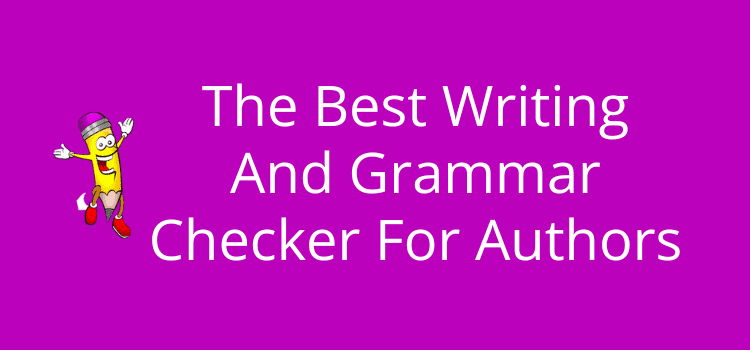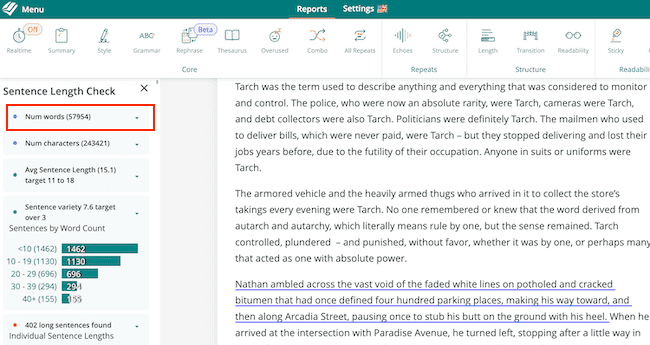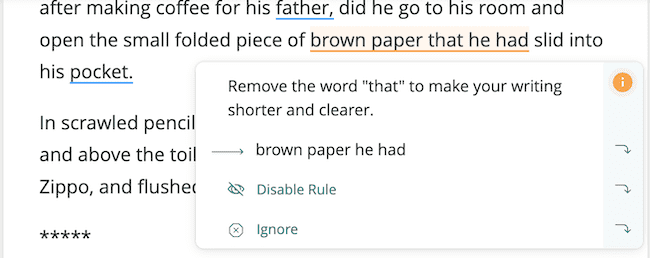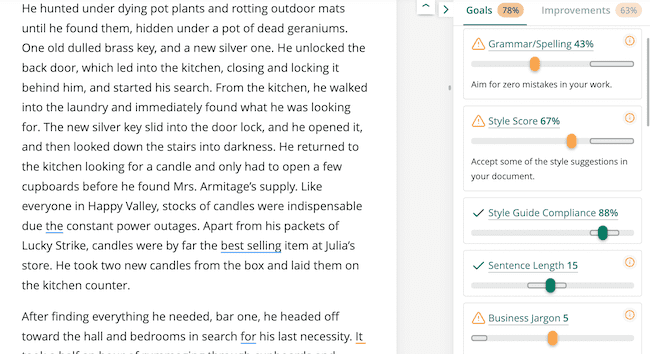
For authors, a writing and grammar checker has to perform many more functions than simply checking for errors and typos.
Yes, you can find a lot of free and paid tools to check your writing. But most of them have restrictions, particularly with maximum word count limitations.
A manuscript is a very long document. If you can only check 1,000 words at a time, it’s not a great help, especially for consistency. If you spell a character’s name slightly differently in chapters two and ten, it’s not easy to find, even with meticulous proofreading.
That’s why it is important to be very selective when choosing a tool to check and correct your writing.
Checking a full book manuscript
Many writers and authors use a premium grammar checker, and Grammarly is probably the most popular.
In fact, I’m using it now as I write this article. It’s a terrific tool for checking my writing with any online editor like WordPress.
But it has a maximum limit of 100,000 characters, including spaces. That is approximately 14,500 words if you use an average formula of six letters plus a space for a word in a text.
It applies to both the browser extension and desktop editor.
If you are working on a long book manuscript of 60-80,000 words, you have to split it into two or three chapters at a time.
But what if you have a character that is Cathy in chapter two and Kathy in chapter fifteen? Or, you use US spelling for center early in the book but use the UK spelling centre in later chapters?
Because it takes a long time to write a book, it’s easy to have mixed quotation marks. Perhaps you used double curly when writing on your laptop, but you wrote some of the text on your iPad, and it used double straight.
Finding consistency problems like these is extremely difficult if you are working on chunks of your manuscript.
As far as I know, for authors, there is only one writing and grammar checker with no maximum word count limitation.
And that’s why I always use Prowritingaid when working on a book manuscript.
Uploading your manuscript
With most writing apps and tools, it’s not possible to upload a full manuscript.
But that’s not the case here.
When you check the Prowritingaid FAQs, it says this:
Although ProWritingAid does not have a maximum word count, it works best when looking at fewer than 10,000 words at a time.
It’s true that it will work much faster on shorter texts, but it also makes it clear that there is no maximum word count.
So you can upload your complete manuscript and get to work.
When you do, you will see this warning.

Select the option to continue, and your full document will load.
You might also see an option to split your manuscript into chapters.
But don’t select this option if you want to work on your full manuscript.
You can see below my uploaded document is just under 60,000 words.

It only took a few seconds to load, so now it’s time to get to work.
Checking for consistency
Any reports or checks you run will be a little slower with a long document. But they always run and complete.
Here’s the first check I ran to highlight all inconsistencies in the text.

The report took around 20 seconds to complete, so it’s not really slow by any means.
From this report, I can click on each item on the left and check each occurrence in the text.
Spelling inconsistency is where you will find problems with character name variations or mixed US and UK spelling uses.
You can also quickly access inconsistencies in quotation marks and other punctuation.
Real-time Reports
The real-time report is at the top left of the main menu.

The ticker took around 2 minutes to complete when I ran my first check. As you can see, it found 2,064 points to check in my unedited manuscript.
However, while it was running, I could check my text and make corrections on the fly.
Here’s an example of a one-click correction you can make as you scan your text.

There is no lag or hesitation as you make these corrections while the scan is still running.
But you can also see and access individual reports on the right of the editing screen.
When the scan is completed, you will see your final text analysis score for each element.
It’s a long list, but here are two sections of the live reports on the right-side menu.
This is the section showing style elements.

Another section looks at grammar and related areas.

Selecting any of these will take you to a specific element to check and correct.
The best part is that none of these checks will slow down or lag, even when checking a very long manuscript.
It’s not slow at all
While you might experience slight lags when working on a manuscript of over 60,000 words, it’s not a great inconvenience.
The benefits of being able to work on your full text far outweigh minor speed issues.
If you want to be able to locate inconsistencies in a text, the only way is to check it from the first word to the last word.
That’s why Prowritingaid is always the tool I use for checking a manuscript of any length.
The pros and cons of Prowritingaid
While it’s a terrific tool, nothing is perfect.
So before you consider whether it’s for you, here are some quick points for you to assess.
Pros
No maximum word or character count limitation.
Easy to learn how to use.
Twenty comprehensive reports and style checks.
Competitive annual subscription price.
Option to purchase for only one month.
Cons
The free version is extremely limited.
You have to pay extra for plagiarism checks.
Not as many integrations as Grammarly.
Internet-dependent, so you must be online to use it.
Summary
With so many premium and free writing tools available today, writers are spoiled for choice.
But for authors, a writing and grammar checker must do much more than the basics.
If you already use Grammarly, you have a great tool to use, so I wouldn’t suggest you go to the extra expense.
But you are limited in how many words you can check.
I use both Grammarly and Prowritingaid because I write a lot, and the extra cost is worthwhile for me. But that’s not the case for all writers.
It’s up to you to make the best choice for your writing needs.
But I have to say in closing that if you are getting ready to publish your first book, the best way to check a complete manuscript in full is with Prowritingaid.
It’s the only tool around that lets you load up your whole book text and get to work on ironing out all the little inconsistencies that can happen in a new book.
But as with all checking apps, none of them are 100% perfect or foolproof.
They can help you a lot and find most errors or irregularities. But you still need to do careful human proofreading before you publish.
Related Reading: Prowritingaid And Grammarly Desktop Editor Review




I find Quillbot to be the best free grammar-checking tool, Grammarly misses a lot whereas Quillbot doesn’t. Unfortunately, they don’t have a Mac or iPad version yet so it’s a real pain to use, because when I switch pages it resizes and loses the assistant.
However for free for a new budding writer, it’s worth the hassle because it saves time waiting on free editors.
Free writing checkers are always very limited, so they are rarely useful for editing a complete book manuscript.